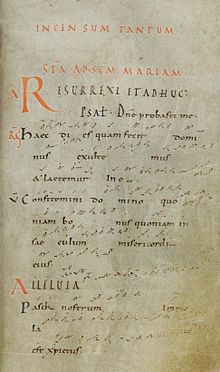Codex Sangallensis 359

The Codex Sangallensis 359 contains 922 to 926 in St. Gallen created Cantatorium that in the St. Gallen Abbey Library is kept. It is the oldest completely preserved manuscript of Gregorian proprium chants with neumes . It therefore plays a key role in the restitution of Gregorian chant .
content
The wooden box (28 cm × 12.5 cm) decorated with an ivory plaque from the possession of Charlemagne contains, on 166 pages, mainly the medieval mass chants of the proprium (liturgy) of the church year and the festivals of the saints .
Furthermore, some hymns and alleluia verses were added in the 10th to 13th centuries .
The Codex has been available online in the virtual library of the University of Friborg (Switzerland) since May 24, 2007 .
history
The Codex Sangallensis 359 is famous in medieval musicology because the manuscript is the oldest known complete cantatorium. It was used by the cantor for solo singing. Ekkehart IV. Mentioned in the monastery chronicle Casus Sancti Galli , which he temporarily kept , that this cantatorium had been kept on a desk stand in the basilica of the prince abbey of St. Gallen . Dendrochronological studies have shown that it most likely dates from the time of Abbot Hartmann after 922.
The Benedictine monks of the Abbey of Saint Peter in Solesmes in France , especially Dom André Mocquereau , compared the neumes of the Codex Sangallensis 359 with other manuscripts and analyzed them in detail. Building on this, it is now possible to provide very precise and reliable information about the repertoire and the interpretation of the chants.
literature
- André Mocquereau , Cantatorium de Saint-Gall ( Paléographie musicale . Tome II, 2), Tournai 1924
- Godehard Joppich , Die Manschrift St. Gallen Stiftsbibliothek 359. Cantatorium (Monumenta Palaeographica Gregoriana), Essen / Münsterschwarzach 1988
Web links
- Codices Electronici Sangallenses CSG 359
- Codex Sangallensis in the St. Gallen Abbey Library
- The St.Gallen Cantatorium
